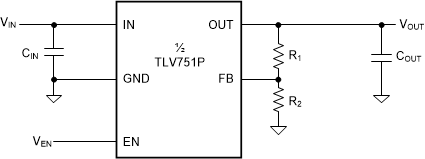JAJSI89B December 2019 – April 2020 TLV751
PRODUCTION DATA.
8.1.1 Adjustable Device Feedback Resistors
Figure 38 shows that the output voltage of the TLV751 can be adjusted from 0.55 V to 5.5 V by using a resistor divider network.
 Figure 38. Adjustable Operation
Figure 38. Adjustable Operation The adjustable-version device requires external feedback divider resistors to set the output voltage. VOUT is set using the feedback divider resistors, R1 and R2, according to the following equation:
For this device, VFB = 0.55 V.
To ignore the FB pin current error term in the VOUT equation, set the feedback divider current to 100x the FB pin current listed in the Electrical Characteristics table. This setting provides the maximum feedback divider series resistance, as shown in the following equation:
For this device, IFB = 10 nA.